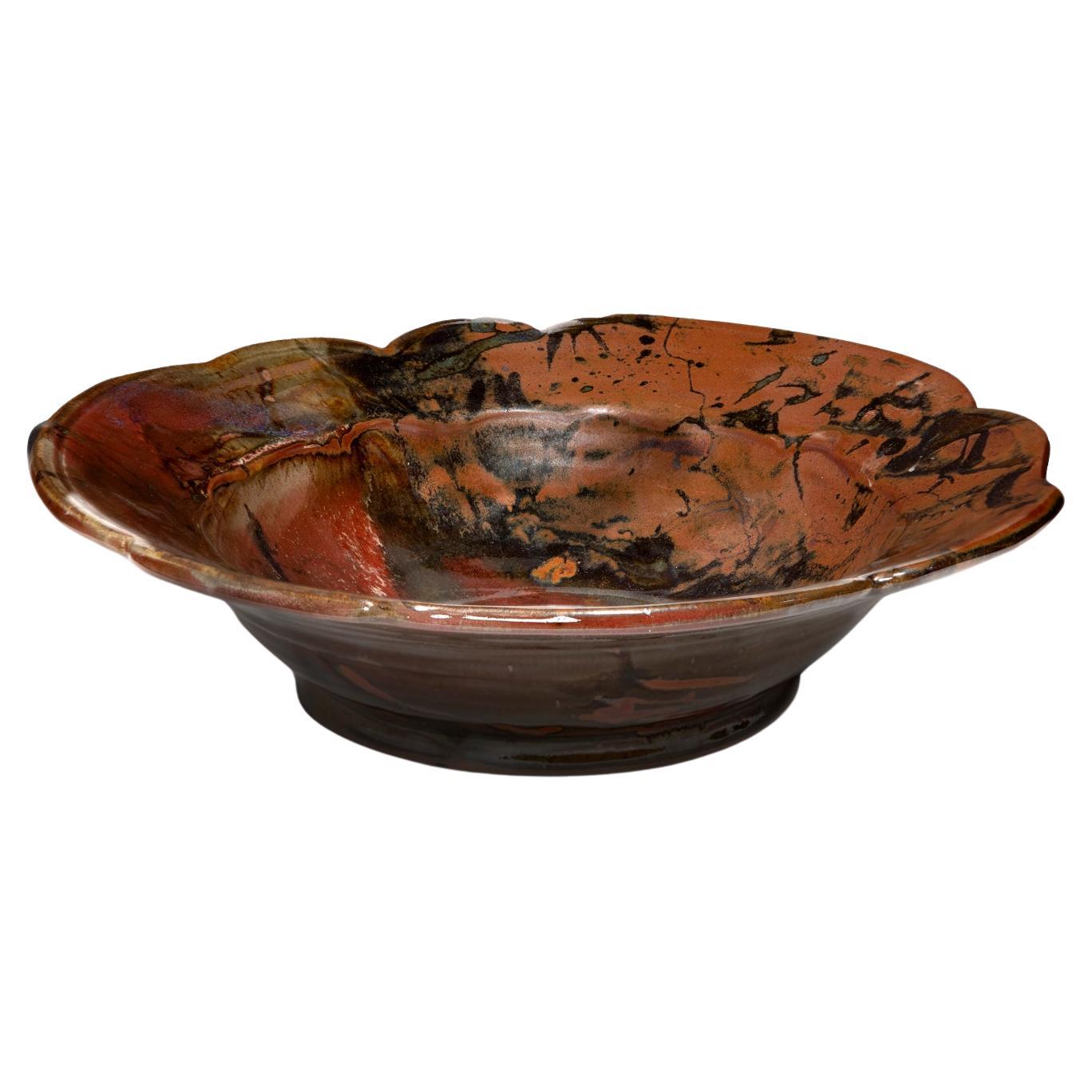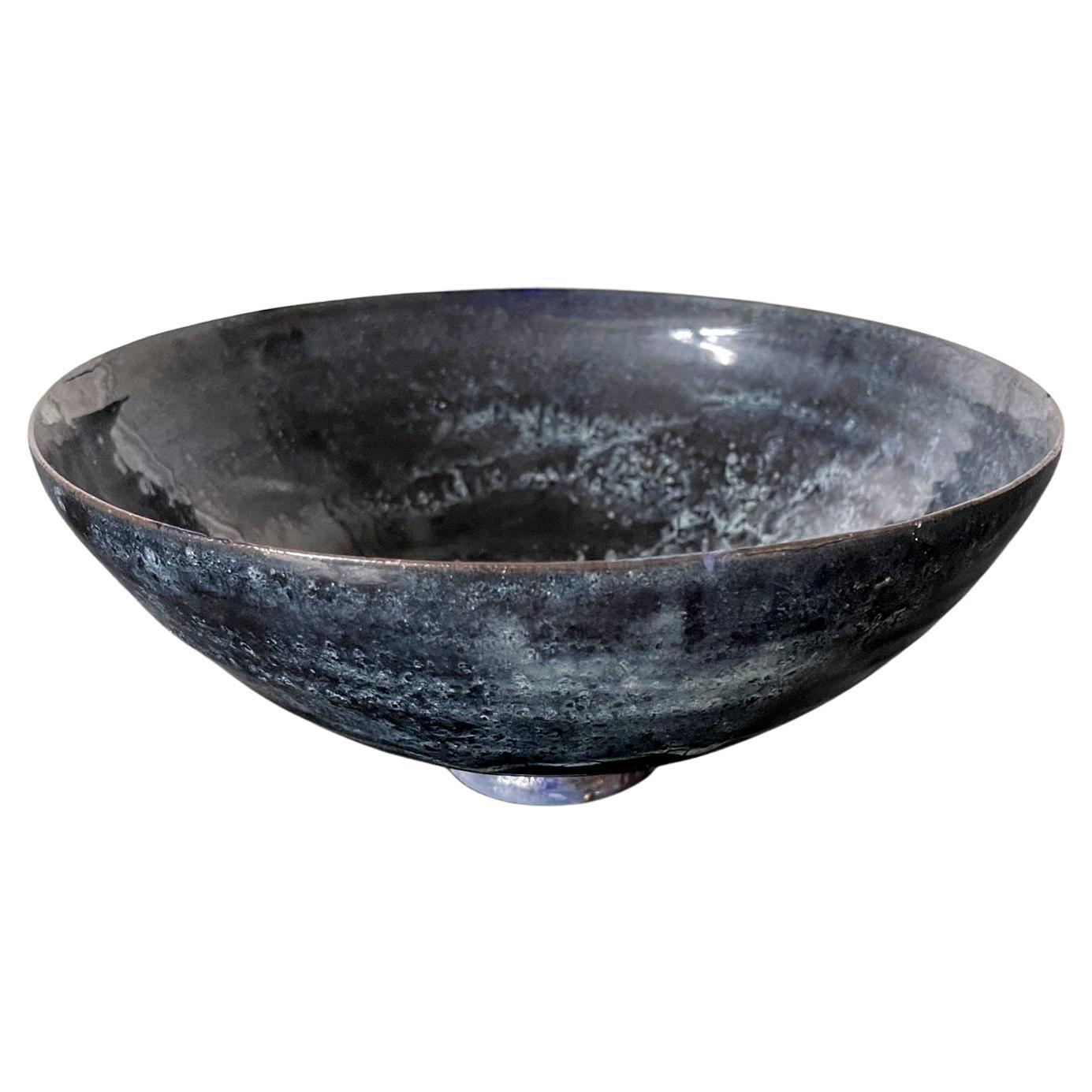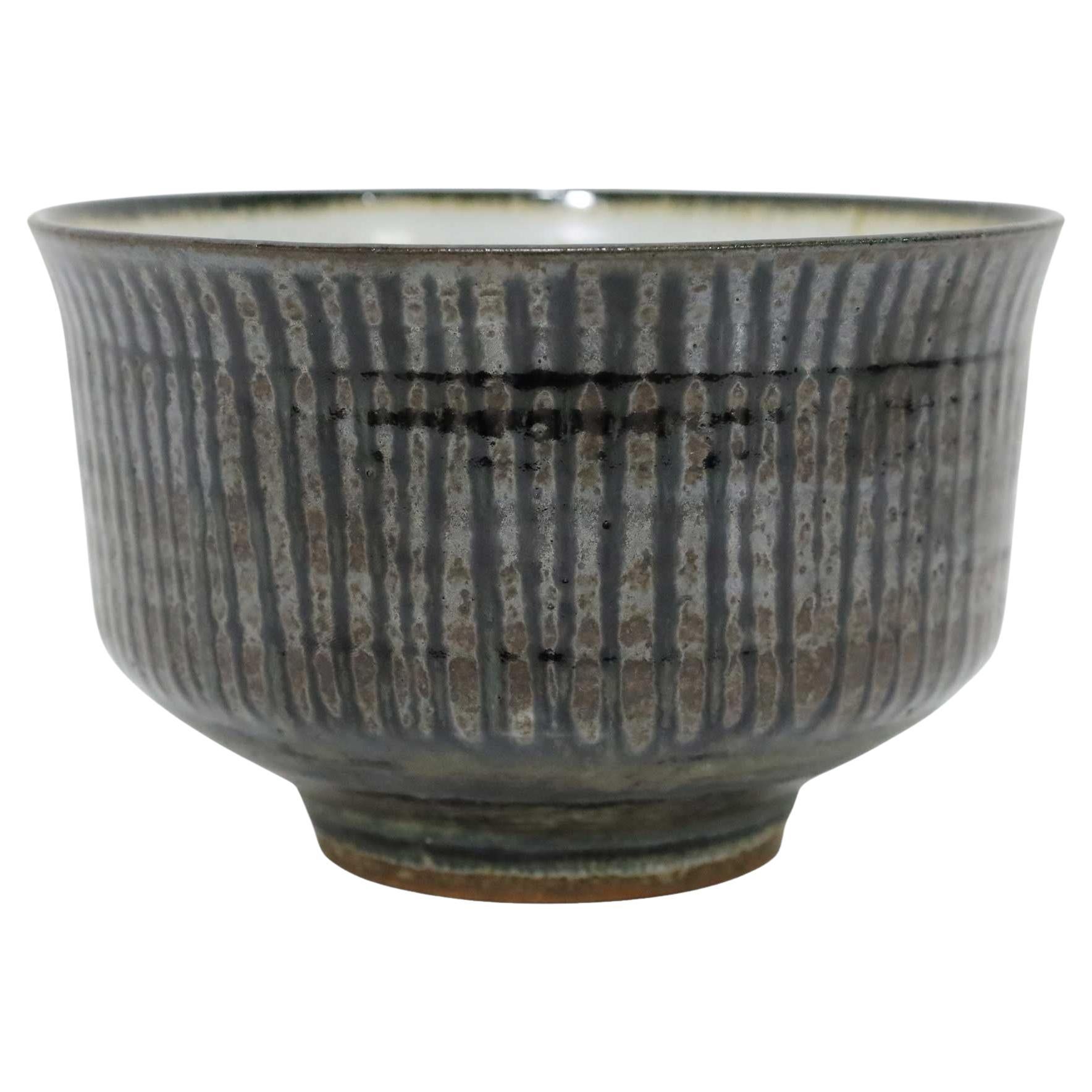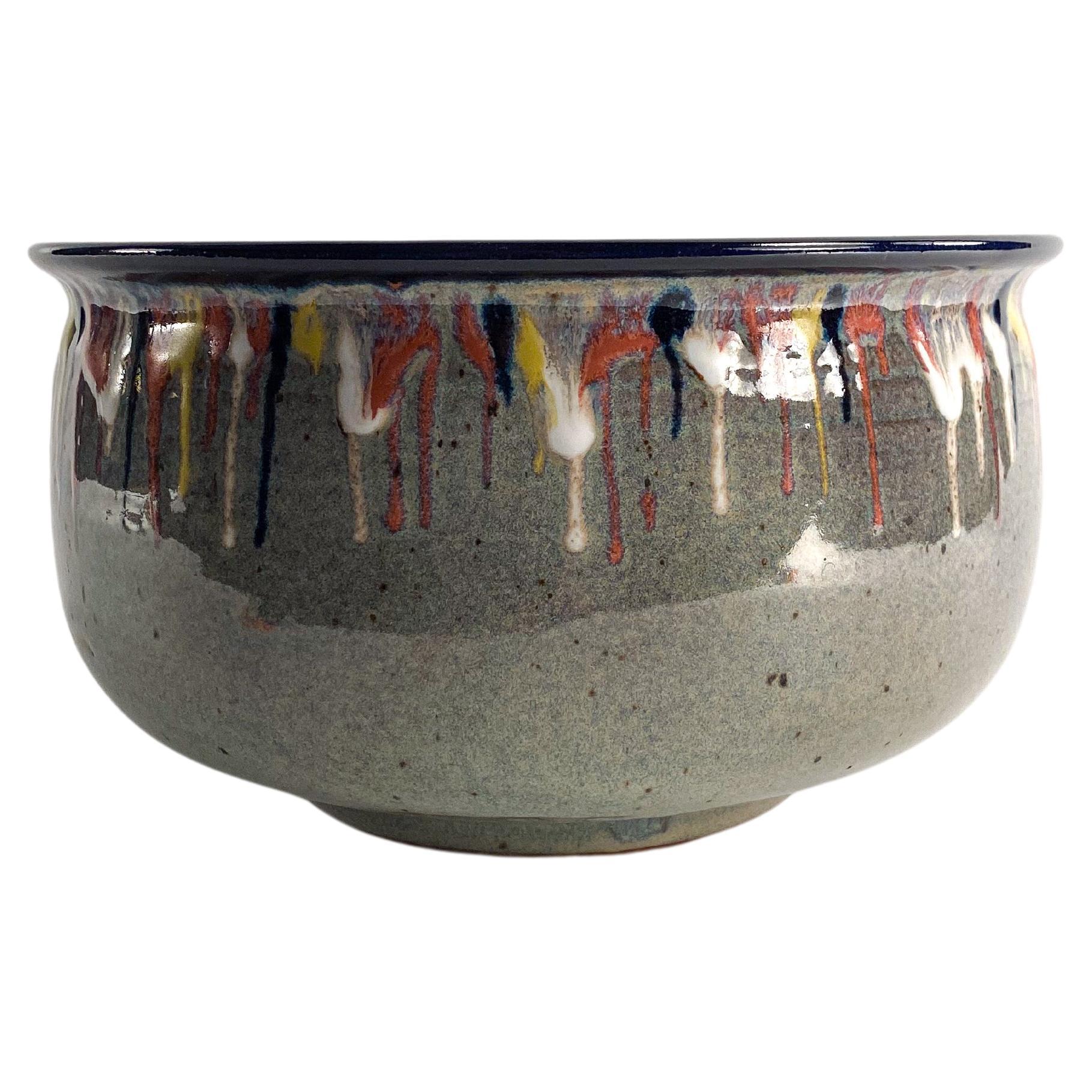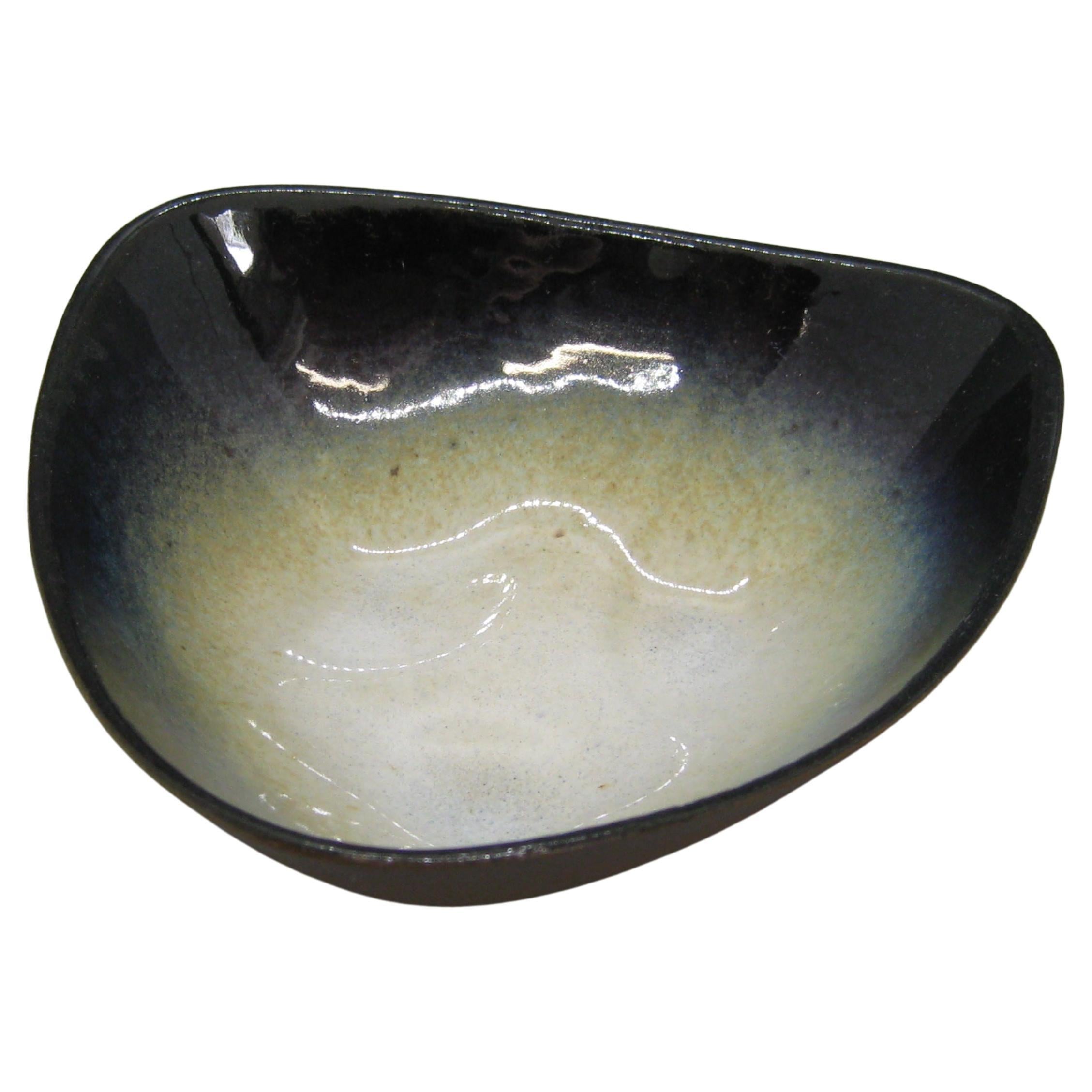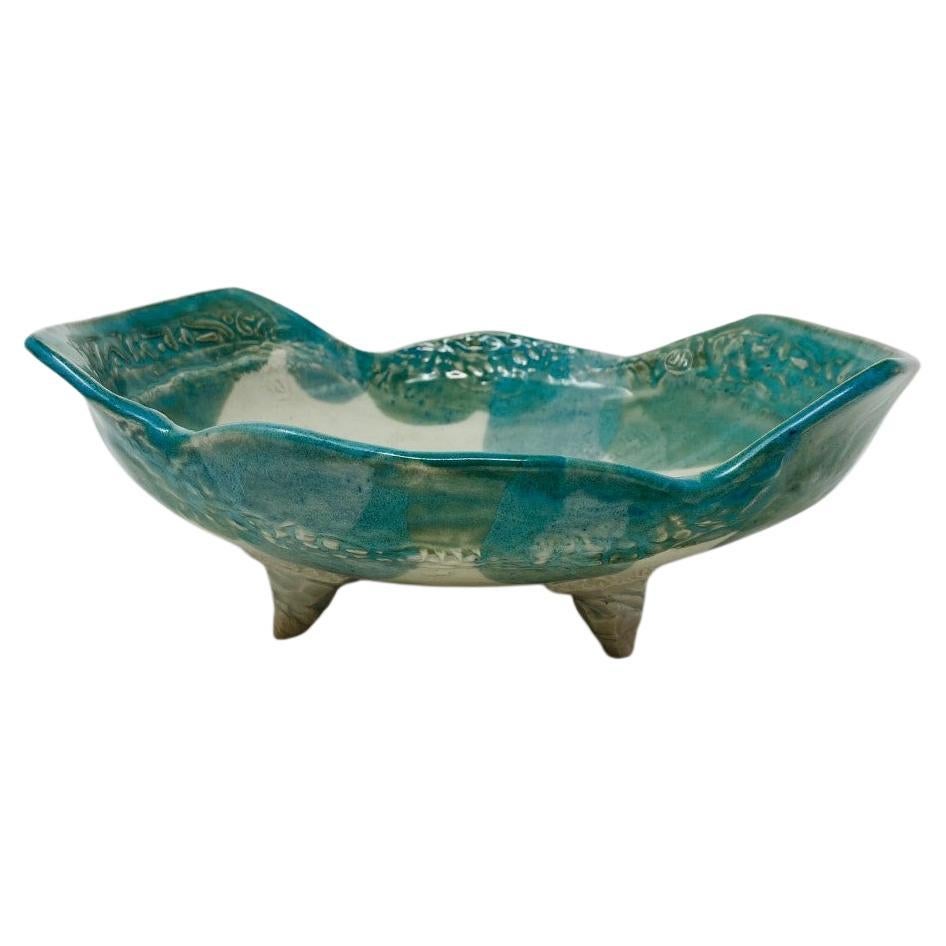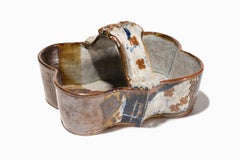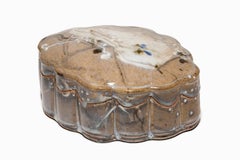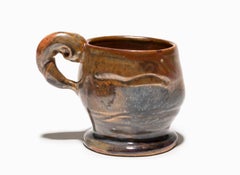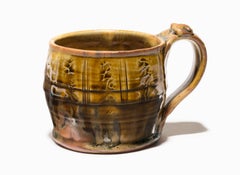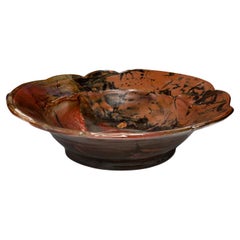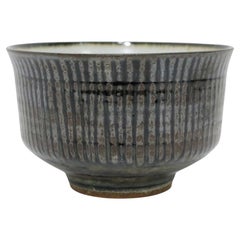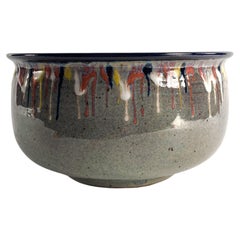Items Similar to John Glick Plum Street Pottery Glazed Bowl Reduction Fired
Want more images or videos?
Request additional images or videos from the seller
1 of 10
John GlickJohn Glick Plum Street Pottery Glazed Bowl Reduction Fired1970s
1970s
$1,250
£944.55
€1,093.24
CA$1,753.69
A$1,950.60
CHF 1,023.28
MX$23,801.81
NOK 12,843.51
SEK 12,103.45
DKK 8,160.55
About the Item
"Untitled" is a stoneware piece with the decorative layer of the rich toned glazes and markings that John was so well-known for. Each piece that John produced was unique. The lip on this piece is slightly scalloped and the shape is removed from the boring circular to mimic a gentle geometric design. He was seduced by the effects of the reduction kiln, which decreased the levels of oxygen during firing, inducing the flame to pull oxygen out of the clay and glazes changing the colors of the glazes depending on their iron and copper content. In this way he achieved the rich gradients of ochre and umber and variations in stippling and opacity. This piece is signed and stamped on the bottom.
John was an American Abstract Expressionist ceramicist born in Detroit, MI. Though open to artistic experimentation, Glick was most influenced by the styles and aesthetics of Asian pottery—an inspiration that shows in his use of decorative patterns and glaze choices. He has said that he is attracted to simplicity, as well as complexity: my work continually reflects my re-examination that these two poles can coexist… or not, in a given series. Glick also took influences from master potters of Japan, notably Shoji Hamada and Kanjrio Kawai, blending their gestural embellishments of simple forms with attitudes of Abstract Expressionism. He was particularly drown to the work of Helen Frankenthaler whose soak-stain style resonated with Glick’s multi-layered glaze surfaces, which juxtaposed veils of atmospheric color with gestural marks and pattern. He spent countless hours developing and making his own tools in order to achieve previously unseen results in his work with clay and glaze.
Glick’s “Plum Tree Pottery” (now a designated historic landmark in Farmington Hills, Michigan) studio opened around 1965 and closed in the summer of 2016. It was a private studio space for John and a number of his students and assistants. He believed his shapes evolved guided by forces apparently outside his control. This was instinctual, intellectual and due to his openness to change, fusing into what he thought was the most positive force behind a potter’s approach: evolution and growth. Some have called it inspiration.
John was not only a major figure in the Detroit creative community, but in the ceramics world at large. According to Shelley Selim in her book on John, “John Glick: A Legacy in Clay” John remains: “one of the most recognizable names in the field of studio pottery – known for lecturing, publishing, and offering workshops widely – and his work has been featured in well over a hundred local, national and international exhibitions since he was a college student in the late 1950s.” Along with this John has mentored over thirty studio apprentices over five and a half decades, received numerous grants and awards for his work, and has been prolific, with an estimated 300,000 ceramic wares throughout the world.
He received his Masters from Cranbrook Academy of Art in Bloomfield Hills, Michigan, working with Maija Grotell, a legendary and influential teacher. Grotell was noted for her deep interest in the human connection to nature’s rhythms and patters. These ideas often grounded her dialog with her students including Glick, affecting, a profund and lasting influence on his future work. This famous Art Academy was designed by architect and faculty member, Eliel Saarinen who collaborated with Charles and Ray Eames on chair and furniture design. Numerous creative artists who are alumni of Cranbrook include: Harry Bertoia, Florence Knoll, Jack Lenor Larsen, Donald Lipski, Duane Hanson, Nick Cave, Hani Rashid, George Nelson, Urban Jupena (Nationally recognized fiber artist), Artis Lane (the first African-American artist to have her sculpture, "Sojourner Truth," commissioned for the Emancipation Hall in the Capital Visitor Center in Washington DC), Cory Puhlman (televised Pastry Chef extraordinaire), Thom O’Connor (Lithographs), Paul Evans (Brutalist-inspired sculpted metal furnishings), Eugene Caples (small bronze images/abstract), Morris Brose (Bronze Sculptures), Herb Babcock (blown glass), Larry Butcher (mixed media) and Lauren Anais Hussey (Abstract).
Glick’s work can be found in private and public collections in Michigan at The Cranbrook Museum of Art, The Detroit Institute of Arts, The Flint Institute of Arts, Wayne State University and University of Michigan, in addition to major museums across the U.S. and Internationally.
- Creator:John Glick
- Creation Year:1970s
- Dimensions:Height: 4 in (10.16 cm)Diameter: 12.5 in (31.75 cm)
- Medium:
- Movement & Style:
- Period:
- Condition:
- Gallery Location:Detroit, MI
- Reference Number:1stDibs: LU128617297172
About the Seller
5.0
Vetted Professional Seller
Every seller passes strict standards for authenticity and reliability
Established in 2014
1stDibs seller since 2019
108 sales on 1stDibs
Typical response time: 18 hours
- ShippingRetrieving quote...Shipping from: Detroit, MI
- Return Policy
Authenticity Guarantee
In the unlikely event there’s an issue with an item’s authenticity, contact us within 1 year for a full refund. DetailsMoney-Back Guarantee
If your item is not as described, is damaged in transit, or does not arrive, contact us within 7 days for a full refund. Details24-Hour Cancellation
You have a 24-hour grace period in which to reconsider your purchase, with no questions asked.Vetted Professional Sellers
Our world-class sellers must adhere to strict standards for service and quality, maintaining the integrity of our listings.Price-Match Guarantee
If you find that a seller listed the same item for a lower price elsewhere, we’ll match it.Trusted Global Delivery
Our best-in-class carrier network provides specialized shipping options worldwide, including custom delivery.More From This Seller
View AllBreathtaking John Glick "Scalloped Basket" Glazed Stoneware Reduction Fired
Located in Detroit, MI
"Scalloped Basket" is a stoneware piece with the decorative layer of the rich toned glazes and markings that John was so well-known for. He was, also, known for the undulating lip lines on his exquisite pieces. The basket portion is shaped with gentle curves and a sculptural handle. Each piece that John produced was unique. He was seduced by the effects of the reduction kiln, which decreased the levels of oxygen during firing, inducing the flame to pull oxygen out of the clay and glazes changing the colors of the glazes depending on their iron and copper content. In this way he achieved the rich gradients of ochre and umber and variations in stippling and opacity. This particular "basket" also has the cool blues and grays that contrast with the umber. It is signed and stamped on the bottom.
John was an American Abstract Expressionist ceramicist born in Detroit, MI. Though open to artistic experimentation, Glick was most influenced by the styles and aesthetics of Asian pottery—an inspiration that shows in his use of decorative patterns and glaze choices. He has said that he is attracted to simplicity, as well as complexity: my work continually reflects my re-examination that these two poles can coexist… or not, in a given series. Glick also took influences from master potters of Japan, notably Shoji Hamada and Kanjrio Kawai, blending their gestural embellishments of simple forms with attitudes of Abstract Expressionism. He was particularly drown to the work of Helen Frankenthaler whose soak-stain style resonated with Glick’s multi-layered glaze surfaces, which juxtaposed veils of atmospheric color with gestural marks and pattern. He spent countless hours developing and making his own tools in order to achieve previously unseen results in his work with clay and glaze.
Glick’s “Plum Tree Pottery...
Category
1970s American Modern Abstract Sculptures
Materials
Stoneware, Glaze
Magnificent John Glick Plum Street Pottery "Scalloped Box" Glazed Stoneware
Located in Detroit, MI
This magnificent "Scalloped Box" is a stoneware piece with decorative layers of rich toned glazes and markings that John was so well-known for. He was, also, known for the undulating lip lines on his exquisite boxes that fit together like a puzzle. Each piece that John produced was unique. He was seduced by the effects of the reduction kiln, which decreased the levels of oxygen during firing, inducing the flame to pull oxygen out of the clay and glazes thereby changing the colors of the glazes depending on their iron and copper content. In this way he achieved the rich gradients of ochre and umber and variations in stippling and opacity. This piece is signed and stamped on the bottom.
John was an American Abstract Expressionist ceramicist born in Detroit, MI. Though open to artistic experimentation, Glick was most influenced by the styles and aesthetics of Asian pottery—an inspiration that shows in his use of decorative patterns and glaze choices. He has said that he is attracted to simplicity, as well as complexity: my work continually reflects my re-examination that these two poles can coexist… or not, in a given series. Glick also took influences from master potters of Japan, notably Shoji Hamada and Kanjrio Kawai, blending their gestural embellishments of simple forms with attitudes of Abstract Expressionism. He was particularly drown to the work of Helen Frankenthaler whose soak-stain style resonated with Glick’s multi-layered glaze surfaces, which juxtaposed veils of atmospheric color with gestural marks and pattern. He spent countless hours developing and making his own tools in order to achieve previously unseen results in his work with clay and glaze.
Glick’s “Plum Tree Pottery...
Category
Late 20th Century American Modern Abstract Sculptures
Materials
Stoneware, Glaze
John Glick Plum Street Pottery Reduction Fired Shino Glaze Cup Published in Book
Located in Detroit, MI
“Untitled” ceramic, is an example of the kind of work by which John Glick became so famous. He was seduced by the effects of the reduction kiln, which decreased the levels of oxygen during firing, inducing the flame to pull oxygen out of the clay and glazes changing the colors of the glazes depending on their iron and copper content. In this way he achieved the rich gradients of ochre and umber and variations in stippling and opacity.
This piece is signed on the bottom and can be found on page 92, plate #125 in “John Glick: A Legacy in Clay.”
John was an American Abstract Expressionist ceramicist born in Detroit, MI. Though open to artistic experimentation, Glick was most influenced by the styles and aesthetics of Asian pottery—an inspiration that shows in his use of decorative patterns and glaze choices. He has said that he is attracted to simplicity, as well as complexity: my work continually reflects my re-examination that these two poles can coexist… or not, in a given series. Glick also took influences from master potters of Japan, notably Shoji Hamada and Kanjrio Kawai, blending their gestural embellishments of simple forms with attitudes of Abstract Expressionism. He was particularly drown to the work of Helen Frankenthaler whose soak-stain style resonated with Glick’s multi-layered glaze surfaces, which juxtaposed veils of atmospheric color with gestural marks and pattern. He spent countless hours developing and making his own tools in order to achieve previously unseen results in his work with clay and glaze.
Glick’s “Plum Tree Pottery...
Category
1990s American Modern More Art
Materials
Stoneware, Glaze
John Glick Plum Tree Pottery , Stoneware Mug, Deep Earth Tones, Glazed
Located in Detroit, MI
“Untitled” ceramic, is an example of the kind of work by which John Glick became so famous. He was seduced by the effects of the reduction kiln, which decreased the levels of oxygen during firing, inducing the flame to pull oxygen out of the clay and glazes changing the colors of the glazes depending on their iron and copper content. In this way he achieved the rich gradients of ochre and umber and variations in stippling and opacity.
This piece is signed on the bottom and can be found on page 129, plate #236 in “John Glick: A Legacy in Clay.”
John was an American Abstract Expressionist ceramicist born in Detroit, MI. Though open to artistic experimentation, Glick was most influenced by the styles and aesthetics of Asian pottery—an inspiration that shows in his use of decorative patterns and glaze choices. He has said that he is attracted to simplicity, as well as complexity: my work continually reflects my re-examination that these two poles can coexist… or not, in a given series. Glick also took influences from master potters of Japan, notably Shoji Hamada and Kanjrio Kawai, blending their gestural embellishments of simple forms with attitudes of Abstract Expressionism. He was particularly drown to the work of Helen Frankenthaler whose soak-stain style resonated with Glick’s multi-layered glaze surfaces, which juxtaposed veils of atmospheric color with gestural marks and pattern. He spent countless hours developing and making his own tools in order to achieve previously unseen results in his work with clay and glaze.
Glick’s “Plum Tree Pottery...
Category
Late 20th Century American Modern More Art
Materials
Stoneware, Glaze
John Albert Murphy Porcelain "Dark Days Ahead" Sculptural Nested Bowls
Located in Detroit, MI
"Dark Days Ahead" is in fact a glorious paper-thin porcelain sculpture with fluted sides. The "two bowls and one ball" are nestled and permanently fixed. The black and white linear design to the porcelain is relieved by the movement of the fluted sides of the "bowls." This complex design is both light and airy while being visually weighted by the innermost "ball" being covered in a silver glaze suggesting heavy stainless steel. The ceramic piece is slip cast porcelain, masking tape stenciled and glazed in the style of abstract expressionism, specifically Pointillism. It was fired in oxidation at 2230 degrees Fahrenheit. The sphere in the center has luster glaze.
John Albert Murphy...
Category
21st Century and Contemporary Assemblage Abstract Sculptures
Materials
Porcelain, Glaze
"Stoneware Vessel" Cream Glaze with Organic Decorations, Signed
By Gawaine Dart
Located in Detroit, MI
The rich tones of the stoneware clay come through the soft creamy glaze that drips over the surface like melted vanilla ice cream over red devil cake. This beautifully rendered ceramic vessel is perched on little decorative feet that poke out of the body of the piece. Of particular interest and commanding presence are the decorative forms attached to the top and sides. They twisted shapes of bent organic growth and provide endless entertainment for the creative imagination.
American Post War and Contemporary Artist, Gawaine Dart...
Category
1980s More Art
Materials
Stoneware, Glaze
You May Also Like
John Glick Plum Street Pottery Ceramic Glazed Bowl/Charger Extra-large
By John Glick
Located in Bloomfield Hills, MI
The ceramic bowl is an example of the kind of work by which John Glick became so famous. He was seduced by the effects of the reduction kiln, which decreased the levels of oxygen during firing, inducing the flame to pull oxygen out of the clay and glazes changing the colors of the glazes depending on their iron and copper content. In this way he achieved the rich gradients of ochre and umber and variations in stippling and opacity. It is signed by the artist and stamped with Plum Street Pottery on the verso.
John was an American Abstract Expressionist ceramicist born in Detroit, MI. Though open to artistic experimentation, Glick was most influenced by the styles and aesthetics of Asian pottery—an inspiration that shows in his use of decorative patterns and glaze choices. He has said that he is attracted to simplicity, as well as complexity: my work continually reflects my re-examination that these two poles can coexist… or not, in a given series. Glick also took influences from master potters of Japan, notably Shoji Hamada and Kanjrio Kawai, blending their gestural embellishments of simple forms with attitudes of Abstract Expressionism. He was particularly drown to the work of Helen Frankenthaler whose soak-stain style resonated with Glick’s multi-layered glaze surfaces, which juxtaposed veils of atmospheric color with gestural marks and pattern. He spent countless hours developing and making his own tools in order to achieve previously unseen results in his work with clay and glaze.
Glick’s “Plum Tree Pottery” (now a designated historic landmark in Farmington Hills, Michigan) studio opened around 1965 and closed in the summer of 2016. It was a private studio space for John and a number of his students and assistants. He believed his shapes evolved guided by forces apparently outside his control. This was instinctual, intellectual and due to his openness to change, fusing into what he thought was the most positive force behind a potter’s approach: evolution and growth. Some have called it inspiration.
John was not only a major figure in the Detroit creative community, but in the ceramics world at large. According to Shelley Selim in her book on John, “John Glick: A Legacy in Clay” John remains: “one of the most recognizable names in the field of studio pottery – known for lecturing, publishing, and offering workshops widely – and his work has been featured in well over a hundred local, national and international exhibitions since he was a college student in the late 1950s.” Along with this John has mentored over thirty studio apprentices over five and a half decades, received numerous grants and awards for his work, and has been prolific, with an estimated 300,000 ceramic wares throughout the world.
He received his Masters from Cranbrook Academy of Art in Bloomfield Hills, Michigan, working with Maija Grotell, a legendary and influential teacher. Grotell was noted for her deep interest in the human connection to nature’s rhythms and patters. These ideas often grounded her dialog with her students including Glick, affecting, a profund and lasting influence on his future work. This famous Art Academy was designed by architect and faculty member, Eliel Saarinen who collaborated with Charles and Ray Eames on chair and furniture design. Numerous creative artists who are alumni of Cranbrook include: Harry Bertoia, Florence Knoll, Jack Lenor Larsen, Donald Lipski, Duane Hanson, Nick Cave, Hani Rashid, George Nelson, Urban Jupena (Nationally recognized fiber artist), Artis Lane (the first African-American artist to have her sculpture, "Sojourner Truth," commissioned for the Emancipation Hall in the Capital Visitor Center in Washington DC), Cory Puhlman (televised Pastry Chef extraordinaire), Thom O’Connor (Lithographs), Paul Evans (Brutalist-inspired sculpted metal furnishings), Eugene Caples (small bronze images/abstract), Morris Brose (Bronze Sculptures), Herb Babcock (blown glass), Larry Butcher (mixed media) and Lauren Anais Hussey...
Category
Late 20th Century American Decorative Dishes and Vide-Poche
Materials
Ceramic
Ceramic Bowl with Expressive Glaze by Beatrice Wood
By Beatrice Wood
Located in Atlanta, GA
A ceramic bowl by American artist and studio potter Beatrice Wood (1893-1998). The elegant bowl has a deep half-hemisphere form that is supported by a sho...
Category
Late 20th Century American Modern Vases
Materials
Ceramic
Gerry Williams (American/Indian, 1926-2014) Glazed Ceramic Bowl
By Gerry Williams
Located in Dallas, TX
Gerry Williams is known using stoneware or porcelain to create vessels that are thrown and also for coil built sculptures. Gerry was born in India in 1926 and lived and worked in New...
Category
20th Century American Mid-Century Modern Decorative Bowls
Materials
Ceramic
Drip Glaze Studio Pottery Bowl
Located in Philadelphia, PA
Beautiful multi colored drip glaze bowl with speckled glaze inside. signed by artist on underside.
Category
Early 2000s American Mid-Century Modern Decorative Bowls
Materials
Ceramic
1960's Peter Pots Studio Art Pottery Ceramic Abstract Dish Bowl Rhode Island
By Gertrud and Otto Natzler
Located in San Diego, CA
Wonderful vintage Peter Pots of Rhode Island studio art pottery ceramic triangle bowl dating from the 1960's. Signed by the artist on the bottom. Has a wond...
Category
Mid-20th Century American Decorative Bowls
Materials
Pottery
$220 Sale Price
20% Off
Raku Fired Ceramic Island Bowl by Jerome Heck
Located in San Diego, CA
Beautiful ceramic bowl by Jerome Heck crafted in the Raku firing technique. This one of a kind piece stands on four legs and develops and opens upwards. The glaze has variations of greens that ondulate in shape around the bowl. Inside the bowl, different designs come forward (turtle figure...
Category
1990s American Modern Decorative Bowls
Materials
Clay
$292 Sale Price
24% Off
More Ways To Browse
John Hall Designs
Abstract Studio Pottery
Iron Tree Sculpture
Circular Metal Sculpture
Stoneware Bowl Glazed Large
Multi Color Glass Sculpture
Figural Studio Pottery
Studio Pottery Figure
1970 Studio Art Pottery
Retro Scalloped Bowl
1950s Abstract Ceramic Sculpture
Kiln Chairs
Brutalist Sculpture Figure
Saarinen Cranbrook Chairs
U Shape Chair
Hamada Shoji
Cranbrook Ceramics
Brutalist Tree Sculpture
